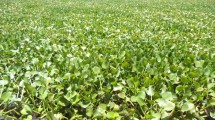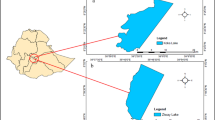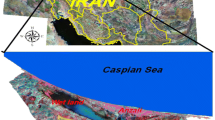Abstract
The spatial and temporal knowledge on spread of invasive aquatic plants helps to determine their extent, abundance, and propagation rates in invaded water systems. Water hyacinth Eichhornia crassipes (Liliales: Pontederiaceae) appeared in Rwandan water bodies in 1957, and it was legislated and accepted as a problematic invasive species in Rwanda in 1999. Water hyacinth has led to a reduction in water quantity and threatened the livelihood of local communities that live off fishing. To comprehend the status of the water hyacinth invasion and assist management strategies, it is important to have detailed and consistent information on its spatio-temporal spread, magnitude, and rate of change dynamics in water systems. This was investigated using time series Landsat satellite images for the years 1989, 2002, and 2017. Image classifications using the nonparametric classifier random forest as well as change detection analysis were carried out to process the satellite data. The results revealed a fluctuation in the extent of water hyacinth over the time series of 1989, 2002, and 2017 with estimated percentage cover of 17.7%, 22.4%, and 20.8%, respectively. An annual increase of 1.9% in water hyacinth invasion was observed from 1989 to 2002; while, a decline of 1.7% per annum was observed from 2002 to 2017. The decline observed in 2017 could be due to manual control undertaken by the government since 2002. This study confirms the potential of using remotely sensed imagery as a valuable method for determining the change in the extent and distribution of invasive alien weeds over time.





Similar content being viewed by others
References
Aboniyo J, Umulisa D, Bizimana A, Kwisanga JMP, Mourad KA (2017) National water resources management authority for a sustainable water use in Rwanda. Sustain Resour Manag J 2(3):01–15
Albright TP, Moorhouse TG, Mcnabb TJ (2004) The rise and fall of water hyacinth in Lake Victoria and the Kagera River Basin, 1989–2001. J Aquat Plant Manag 42:73–84
Anderson JR, Roach JT, Witmer RE (1976) A land use and land cover classification system for use with remote sensor data, geological survey. Professional paper. US Government Printing Office, Washington
Breiman L (2001) Random forests. Mach Learn 45(1):5–32
Canty MJ (2009) Image analysis, classification, and change detection in remote sensing: with algorithms for ENVI/IDL. CRC Press, New York
Cavalli RM, Laneve G, Fusilli L, Pignatti S, Santini F (2009) Remote sensing water observation for supporting Lake Victoria weed management. J Environ Manag 90:2199–2211
Chen G, Hay GJ, Carvalho LMT, Wulder MA (2012) Object-based change detection. Int J Remote Sens 33(14):4434–4457
Cheruiyot EK, Mito C, Menenti M, Gorte B, Koenders R, Akdim N (2014) Evaluating MERIS-based aquatic vegetation mapping in Lake Victoria. Remote Sens 6:7762–7782
Cilliers CJ, Hill MP, Ogwang JA, Ajuonu O (2003) Aquatic weeds in Africa and their control. In: Neuenschwander P, Borgemeister C, Langewald J (eds) Biological control in IPM systems in Africa. CAB International Publishing, Wallingford, pp 161–178
Congalton R, Green K (2008) Assessing the accuracy of remotely sensed data: principles and practices. Lewis Publishers, Boca Raton
De Troyer N, Mereta ST, Goethals PLM, Boets P (2016) Water quality assessment of streams and wetlands in a fast growing East African City. Water 8(4):123
Dube T, Gumindoga W, Chawira M (2014) Detection of land cover changes around Lake Mutirikwi, Zimbabwe, based on traditional remote sensing image classification techniques. Afr J Aquat Sci 39(1):89–95
Everitt JH, Yang C, Escobar DE, Webster CF, Leonard RI, Davis MR (1999) Using remote sensing and spatial information technologies to detect and map two aquatic Macrophytes. J Aquat Plant Manag 37:71–80
Giardino C, Bresciani M, Cazzaniga I, Schenk K, Rieger P, Braga F, Matta E, Brando VE (2014) Evaluation of multi-resolution satellite sensors for assessing water quality and bottom depth of Lake Garda. Sensors 14:24116–24131
Gómez C, White JC, Wulder MA (2016) Optical remotely sensed time series data for land cover classification: a review. ISPRS J Photogramm Remote Sens 116:55–72
Hategekimana S, Twarabamenye E (2007) The impacts of wetlands degradation on water resources management in Rwanda: the case of Rugezi March. In: Proceedings of the 5th international symposium on hydrology, Cairo, Egypt
Hill MP (2003) The impact and control of alien aquatic vegetation in South African Aquatic ecosystems. Afr J Aquat Sci 28(1):19–24
Hoshino B, Karamalla A, Manayeva K, Yoda K, Suliman M, Elgamri M, Nawata H, Yasuda H (2012) Evaluating the invasion strategic of Mesquite (Prosopis juliflora) in eastern Sudan using remotely sensed technique. J Arid Land Stud 22(1):1–4
Islam K, Jashimuddin M, Nath B, Tapan KN (2018) Land use classification and change detection by using multi-temporal remotely sensed imagery: the case of Chunati wildlife sanctuary, Bangladesh. Egypt J Remote Sens Space Sci 21:37–47
Jakubauskas ME, Peterson DL, Campbell SW, deNoyelles F, Campbell SD, Penny D (2002) Mapping and monitoring invasive aquatic plant obstructions in navigable waterways using satellite multispectral imagery. In: Proceedings of the Pecora 15 land satellite information IV conference and the ISPRS commission I symposium. Denver, CO, USA, 10–15 November, 2002
Jones RW (2009) The impact on biodiversity, and integrated control, of water hyacinth, Eichhornia crassipes (Martius) Solms-Laubach (Pontederiaceae) on the Lake Nsezi-Nseleni River System. MSc Thesis, Rhodes University
Joshi C, De Leeuw J, Skidmore AK, van Duren IC, van Oosten H (2006) Remotely sensed estimation of forest canopy density: a comparison of the performance of four methods. Int J Appl Earth Obs Geoinf 8:84–95
Lin X, Sun L, Li M, Guo Z, Zhong K, Xu G (2010) A random forest of combined features in the classification of cut tobacco based on gas chromatograph fingerprint. Talanta 82(4):1571–1575
Macleod RD, Congalton RG (1998) A quantitative comparison of change-detection algorithms for monitoring Eelgrass from remotely sensed data. Photogramm Eng Remote Sens 64(3):207–216
Mather PM (1987) Computer processing of remotely sensed images An introduction, 1st edn. Wiley, Chichester
Mukarugwiro JA, Newete SW, Adam E, Nsanganwimana F, Abitaleb KA, Byrne MJ (2019) Mapping distribution of water hyacinth (Eichhornia crassipes) in Rwanda using multispectral remote sensing imagery. Afr J Aquat Sci 44(4):339–348
Müllerová J, Pergla J, Pyˇseka P (2013) Remote sensing as a tool for monitoring plant invasions: testing the effects of data resolution and image classification approach on the detection of a model plant species Heracleum mantegazzianum (giant hogweed). Int J Appl Earth Obs Geoinf 25:55–65
Ndayisaba F, Nahayo L, Guo H, Bao A, Kayiranga A, Karamage F, Nyesheja EM (2017) Mapping and monitoring the Akagera Wetland in Rwanda. Sustainability 9(2):174–187
Ogwang J, Molo R (2002) Contribution of biological control in management of water hyacinth. Technical report, Fisheries Resources Research Institute (FRRI), Jinja, Uganda
Palmer S, Kutser T, Hunter P (2015) Remote sensing of inland waters: challenges, progress and future directions. Remote Sens Environ 157:1–8
Penatti OAB, Nogueira K, Santos JAD (2015) Do deep features generalize from everyday objects to remote sensing and aerial scenes domains? In: Proceedings IEEE conference on computer vision and pattern recognition workshop, pp 36–43
Pérez EA, Coetzee JA, Téllez TR, Hill MP (2011) A first report of water hyacinth (Eichhornia crassipes) soil seed banks in South Africa. S Afr J Bot 77:795–800
Republic of Rwanda, Ministry of Natural Resources (2014) Forest Landscape Restoration Opportunity Assessment for Rwanda. IUCN, WRI, MINIRENA (Rwanda)
Ritchie JC, Zimba PV, Everitt JH (2003) Remote Sensing techniques to assess water quality. Photogramm Eng Remote Sens 69(6):695–704
Rwanda Environment Management Authority (REMA) (2009) Rwanda State of environment and outlook report. Rwanda Environment Management Authority, Kigali
Rwanda Environment Management Authority (REMA) (2016) Study to assess the impacts of invasive alien species (flowering plants, fish and insects) in natural forests, agro-ecosystems, lakes and wetland ecosystems in Rwanda and develop their management plans. Final report. Kigali, Rwanda
Rwanda Natural Resources Authority (RNRA) (2012) Water quality monitoring in Rwanda (October to December 2012) by the National University of Rwanda Faculty of Science, work conducted under the authority of Rwanda Natural Resources Authority, Kigali Rwanda
Shekede MD, Kusangaya S, Schmidt K (2008) Spatio-temporal variations of aquatic weeds abundance and coverage in Lake Chivero, Zimbabwe. Phys Chem Earth 33:714–721
Singh A (1989) Digital change detection techniques using remotely sensed data. Int J Remote Sens 10(6):989–1003
Sotolu AO (2013) Management and utilization of weed: water hyacinth (Eichhornia crassipes) for improved aquatic resources. J Fishes Aquat Sci 8(1):1–8
Sunar F (1998) Analysis of changes in multidate data set: a case study in Ikitelli area, Istanbul, Turkey. Int J Remote Sens 19:225–236
Thamaga KH, Dube T (2018) Remote sensing of invasive water hyacinth (Eichhornia crassipes): a review on applications and challenges. Remote Sens Appl Soc Environ 10:36–46
Twongo T, Katagira FF, Ochiel GRS, Wadd BNK (2002) Status of water hyacinth infestation and control in River Kagera. Uganda, Lake Victoria Environmental Management Project, Entebbe
van Dam AA, Kipkemboi J (2016) Sustainable use of papyrus from Lake Victoria, Kenya. In: Finlayson C et al (eds) The wetland book. Springer, Dordrecht
Van Vliet J, Bregt AK, Hagen-zanker A (2011) Revisiting kappa to account for change in the accuracy assessment of land-use change models. Ecol Model 222(8):1367–1375
Wulder MA, White JC, Goward SN, Masek JG, Irons JR, Herold M, Cohen WB, Loveland TR, Woodcock CE (2008) Landsat continuity: issues and opportunities for land cover monitoring. Remote Sens Environ 112(3):955–969
Acknowledgements
We would like to express our appreciations to Rwandan government, department of education for letting us to carry out the field surveys in different lakes and rivers of the country. We also acknowledge the staff and managers of the Akagera National Park in Rwanda for consenting us to conduct a field surveys in lakes found in the park and we are also grateful for rangers provided during the surveys. We also acknowledge Centre Invasion Biology (CIB) for sponsoring this study.
Author information
Authors and Affiliations
Corresponding author
Additional information
Editorial responsibility: Anna Grobelak.
Rights and permissions
About this article
Cite this article
Mukarugwiro, J.A., Newete, S.W., Adam, E. et al. Mapping spatio-temporal variations in water hyacinth (Eichhornia crassipes) coverage on Rwandan water bodies using multispectral imageries. Int. J. Environ. Sci. Technol. 18, 275–286 (2021). https://doi.org/10.1007/s13762-020-02824-8
Received:
Revised:
Accepted:
Published:
Issue Date:
DOI: https://doi.org/10.1007/s13762-020-02824-8




